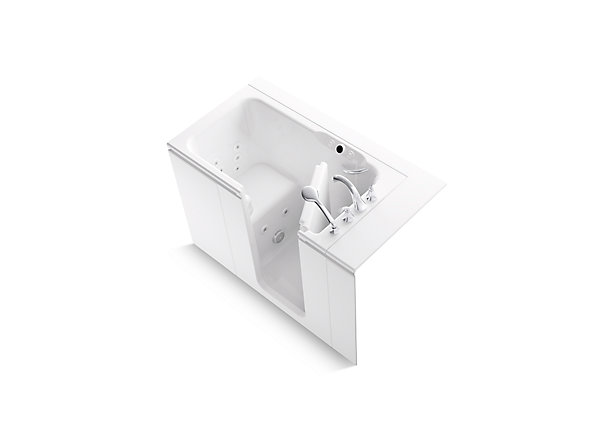Baths Guide
-
Getting Started
-
Bath Installations
-
Bath Design
-
Bath Features
-
Other Considerations
-
-
Bath Types
Bath types are defined and designed by how they can be installed. For example, the exterior of a drop-in bath is unfinished because it will be hidden by a stone or tile surround, whereas a freestanding bath is finished on all sides and can be installed anywhere in the room.
-
Drop-In Baths
A bath designed for drop-in installation has a self-rimming edge that rests on the deck material — such as tile or stone — that surrounds your whirlpool or bathtub. Kits are available to use your drop-in bath in an under-mount installation.
-
Alcove Baths
An alcove is a recessed nook or area within a room. Designed for three-wall alcove installations, this bath type option typically features unfinished exteriors and tile flanges on three sides. Many of these fixtures include an integral apron, the finished front of the bathtub, to complete the design.
-
Under-Mount Baths
Creating a clean, contemporary look, under-mount installation is perfect for designing a separate, personalized bathing space. The bath is mounted beneath your choice of deck material, such as tile, solid surface or natural stone. Most under-mount baths can accommodate a drop-in installation.
-
Freestanding Baths
This installation option is ideal when the bath is the focal point of the room. Typically finished and accessible from all sides, the freestanding bathtub highlights the beauty of the design.
-
Corner Baths
A corner bath is usually five-sided, with a clover-shaped bathing well, and is designed to accommodate two bathers at once.
-
Walk-in Baths
Designed to accommodate bathers who may not be able to step over a standard bathtub threshold, walk-in bath has a side door or a door that opens so bathers don’t need to step over the bath wall.
-
Size
Water Depth
Water depth and bath height are two different measurements. Height is measured from the floor to the top edge of the bath. The most common heights are 15” or 16”. Depth, however, is the measurement taken from the inside of the bath from the base to the overflow drain. Depth, along with length and width, is measured to determine water volume when the bath is filled. On a related note, before you finalize your bath selections, be sure that your floor can support the weight of the full bath and that your water heater will provide enough hot water to fill it.
Baths with shorter than average depths can be an ideal fit for individuals with restricted mobility. The lower threshold makes it easier to enter and exit the bathtub from a standing position or sitting on the edge of the bath and swinging your legs into the bathing well.
Standard for most baths in the U.S., this depth strikes a balance between accessibility and a comfortable soaking depth. Deep enough to cover individuals of average height, these baths offer the best of both worlds.
Baths with extra-deep bathing wells are excellent for soaking. If you plan to include one or more hydrotherapies in your bathtub, a depth of 16” or greater will make the experience all the more enjoyable. -
Next: Learn about Bath Design
Previous: Getting Started











&$SectionHero$)
&$SectionHero$)
&$SectionHero$)
&$SectionHero$)
&$SectionHero$)

